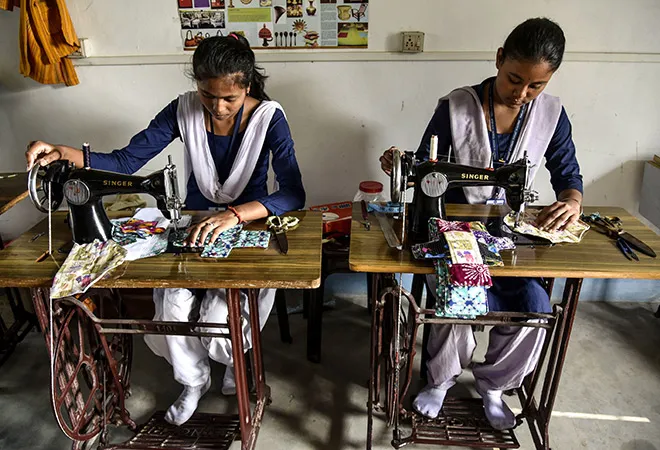
Bihar’s Nawada district usually makes the headlines for Naxal violence. Recently, a 19-year-old woman from the district has been feted for finding a solution to a crisis that had been brewing since the start of the lockdown in March — access to sanitary pads in rural India. Mausam Kumari
started a sanitary pad bank four years ago, based on the idea of microfinance savings, with a voluntary contribution of Re 1 from young girls and women. During the lockdown, she was able to distribute free sanitary pads in villages across the district. In May this year, a
study conducted in Bihar, Uttar Pradesh and Rajasthan by the NGO, Population Foundation of India (PFI), found that more than half of the women surveyed had no access to sanitary pads during the lockdown.
In his speech on Independence Day this year, Prime Minister Narendra Modi
said, “This government has been persistently concerned about better healthcare for poor sisters and daughters. We have done a huge job in providing sanitary pads at one rupee each in Janaushadhi Kendra. In a short of time, more than 5 crore sanitary pads have been delivered to these poor women from 6,000 Janaushadhi Kendras”. He is the first prime minister to address menstrual health as a public health issue. Could this lead to a renewed focus on an aspect of public health that has long been neglected and stigmatised?
PM Narendra Modi is the first prime minister to address menstrual health as a public health issue. Could this lead to a renewed focus on an aspect of public health that has long been neglected and stigmatised?
Just weeks after Modi’s announcement, it was
reported that the government was planning to spend Rs. 12,000 crore to ensure universal access to sanitary pads and to involve corporate houses in the initiative through their CSR (corporate social responsibility) activities. Under the Suvidha brand, the government is selling biodegradable and affordable sanitary pads to women. Suvidha pads are sold at Janaushadhi Kendras stores that provide quality medicines at affordable prices. In 2019, the price of the biodegradable pads was further subsidised to Re 1 from Rs. 2.50 per piece. Though the scheme is well-intentioned, its reach has been limited by gaps in distribution,
irregular supply and lack of awareness—many don’t know about it at all, as this news
report suggested.
In the last decade, policymaking in India has increasingly focused on menstrual health. The Menstrual Hygiene Scheme was launched in 2011 under the National Health Mission for the promotion of menstrual hygiene amongst 15 million adolescent girls in the age group of 10 to 19 in 152 districts across 20 states. The Rashtriya Kishor Swasthya Karyakram (
RKSK) was launched in 2014 to increase awareness of and access to sanitary pads among adolescent girls in rural areas.
Apart from central government schemes, state governments distribute sanitary pads in schools in Uttar Pradesh, Rajasthan, Maharashtra, Odisha, Chhattisgarh, Andhra Pradesh and Kerala. States that do not distribute pads in schools have other provisions, like Bihar, which gives 300 rupees under the
Kishori Swasthya Yojana to adolescent girls to buy sanitary pads. These programs, though effective and necessary to encourage girls to not drop out of school because of menstruation, leave out those girls who are not in school.
Experts
fear that the pandemic—which affected commercial supply chains in the early months—along with the continued closure of schools—where most adolescent girls access sanitary pads—have impacted the gains made in menstrual health, as more girls and women were left with no choice and had to resort to using cloth.
Experts fear that the pandemic—which affected commercial supply chains in the early months—along with the continued closure of schools—where most adolescent girls access sanitary pads—have impacted the gains made in menstrual health
Across the country, outreach services through VHND (Village Health and Sanitation Day), which are organised once a month in villages, have been disrupted by the pandemic. For many young girls and women in the country, VHNDs play a crucial role in providing menstrual health counselling and access, as well as information on the use and safe disposal of sanitary pads. While NGOs stepped in to plug the gap and public health services are resuming, it is a slow limping back to normal.
Some of the core issues, however,
existed before the pandemic. Despite a decade of policy-making and targeted schemes, the adoption of menstrual hygiene in India has a patchy record, a lot of which has to do with awareness levels. The
National Family Health Survey (2015-16) found that usage of pads had gone up substantially, 62 percent women in the country used cloth and 42 percent used sanitary napkins. But there was a huge difference in states. In Bihar, where Mausam Kumari started her sanitary pad bank, 82 percent women depended on cloth. In Uttar Pradesh, 81 percent used homemade alternatives like old cloth, rags, hay, sand, or ash. The survey, not surprisingly, indicated that women with more years of schooling or those from a higher wealth quintile were more likely to use hygienic methods.
Improving the reach and quality of low cost pads is an important part of tackling menstrual health, as
affordability is still the main barrier for the usage of pads in India. If the supply of Suvidha pads can be streamlined, it would make an impact, but that is half the job done. There is a greater need for better information on many fronts.
Improving the reach and quality of low cost pads is an important part of tackling menstrual health, as affordability is still the main barrier for the usage of pads in India
Menstrual health in India is still largely governed by taboos and a lack of information. It needs to be addressed through social and behavioral change programs. There is little knowledge about the health consequences of using unhygienic methods for menstrual management. The usage of cloth, which is a traditional method, in itself is not unhygienic and is also a sustainable option, but it requires washing and drying in the sun. Most women in India do not feel comfortable with the washing and drying because of prevailing taboos, apart from lack of access to water also proving to be a problem.
Though there has been a marked improvement in awareness. A
report by the National Institute of Public Cooperation and Child Development, funded by ICMR, found that the awareness of adolescent girls about menstruation till its onset had gone up from 29.4 percent in 2007 to 72.6 percent in 2012, while knowledge on washing and reusing cloth had gone up from 57.6 to 82.5 percent. There were no recent figures available. The ICMR is currently conducting a study to find cost-effective menstrual hygiene solutions for schoolgirls, like the use of biodegradable sanitary napkins or reusable menstrual cups.
The culture of silence around menstruation in India has become more evident during the pandemic, as Yasmin Ali Haque, UNICEF Representative in India
said in a statement on Menstrual Hygiene Day in May. For menstrual health to be seen as a part of public health and not a women’s issue, that needs to change.
The views expressed above belong to the author(s). ORF research and analyses now available on Telegram! Click here to access our curated content — blogs, longforms and interviews.



 Bihar’s Nawada district usually makes the headlines for Naxal violence. Recently, a 19-year-old woman from the district has been feted for finding a solution to a crisis that had been brewing since the start of the lockdown in March — access to sanitary pads in rural India. Mausam Kumari
Bihar’s Nawada district usually makes the headlines for Naxal violence. Recently, a 19-year-old woman from the district has been feted for finding a solution to a crisis that had been brewing since the start of the lockdown in March — access to sanitary pads in rural India. Mausam Kumari  PREV
PREV


